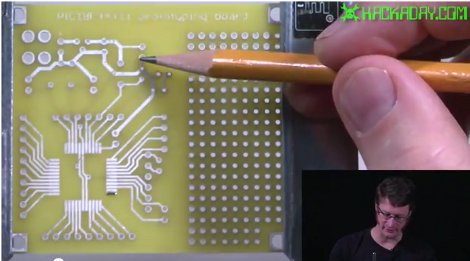
For those of you who followed along with our Eagle CAD series, here is the final payoff where we assemble the circuit board that was designed. In this video, [Jack] explains where things will go on the board and then shows you how to solder the parts. For the advanced folks out there who haven’t moved to solely surface mount parts when you can get away with it, he shows an easy way to solder the processor, which is a TQFP-44 part. This can seem like a daunting task but it really isn’t.
If you would like to make your own board like this, you can find the files here. Please note that although this board shouldn’t have any issues, we haven’t tested it ourselves yet. [Jack] is going to do some videos about a different topic for a few weeks but will pick back up with this board again when they are done.
Video is after the break.














Actually to prevent cold solder you should bring the solder not directly to the tip but rahter to the pad and the component leg while heating it up from the other side of the leg.
Once the solder starts to melt on the pad and the leg you know they have been heated up properly.
Here is how I do my SOIC and TQFP chips, works like a charm, and I dont talk about it forever, I just show it:
http://www.youtube.com/watch?v=MSIyxEUK8Fo&feature=channel_video_title
I agree with every word you said. That is exactly how I solder QFP chips too. 42 second video and Well said.
That stuff in the applicator is solder paste?
looks more like flux to me. look up “drag soldering”
Don’t be afraid to try to reflow at home. I bit the bullet on one project of mine and went nearly 100% surface mount. I did not have a stencil so I placed solder paste on the pads under a microscope. I placed the components with a vacuum chuck and into the oven it went. I tried to follow the paste temp profile as close as one can with a home oven. To my astonishment every connection was perfect, and the board worked. Since I have done 3 more boards this way, with only 1 bad connection. There seems to be allot of fear of re-flowing, so give it a test try with non inportant components/board, you may be surprised. I used Kester R276 no clean solder paste. Next I will try to create a stencil.
P.S.: It’s wise to give moisture sensitive components a back-out according to spec before reflowing.
I bought a 300$ IR oven from China for the purpose and it works perfectly.
But it can be done with hand used hot air tools also.
As long as you have good solder paste it is no problem at all.
Just a note I think that you could slather $1 nail polish on the board as a mask
Why do that? It only makes it harder to make changes.
Probably the idea is to use it as solder mask?
Not to coat the whole board.
When discussing lead-free solder don’t forget to mention Tin Whiskers! That’s pretty much the deal breaker for getting me to switch. Some day I want my grand-kids to inherit things that I made.
whenever I hold onto the solder wick with my fingers 1 inch from where I’m soldering I always burn myself.
I soldered SMD stuff for a living for several years (R&D lab at Siemens, making one off stuff). And I’m always amazed that people think this is so hard to do.
I had no special tools or anything, except a fine tip (on a regular Weller iron), fine gauge solder, and some tweezers.
I’ve even stood SMD resistors on end, on SMD chip pads, then soldered the chip on to those! (checking for current draw).
Really, it’s not that hard.
One of these days I’ll try to video everything and put it on line. There’s so many “tricks” out there.
Once I tried soldering parts with a PCB without solder mask and it was more difficult than with solder mask, shorts all the time. Maybe the desoldering wick trick works, but would be more difficult to use professional soldering techniques with such barebone boards, like shown in this video:
http://www.youtube.com/watch?v=wQXhny3R7lk
How much does the barebone service cost? I’ve used this one:
http://iteadstudio.com/store/index.php?main_page=index&cPath=19_20
And it costs less than a buck for a 5 cm^2 two layer PCB, *with* silk screen and solder mask. Got the PCBs from them yesterday for my upcoming C64 cartridge:
http://www.frank-buss.de/tmp/cartridge-pcb.jpg
How is it that he didn’t have to solder both sides of some of those leads? Like on the header pins. Does the solder melt through the hole and solder both sides? I have NEVER been able to get that to work! I ALWAYS have to solder both sides if a trace is coming off both sides.